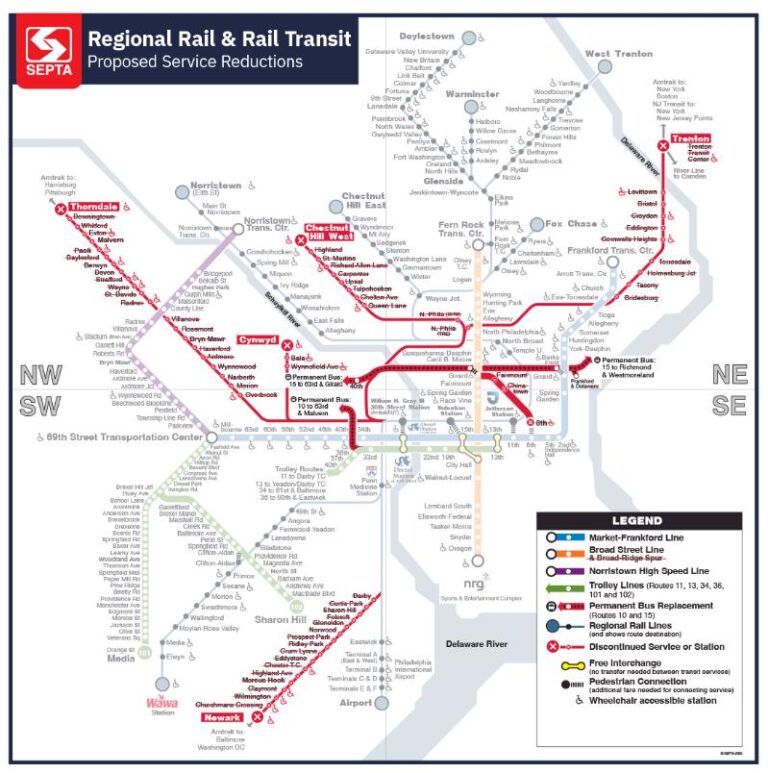PhiladelphiaŌĆÖs Public Transit at a Crossroads: Imminent SEPTA Service Cuts and Funding Challenges
Upcoming SEPTA Service Reductions: What Philadelphia Commuters Should Know
In just under three weeks, PhiladelphiaŌĆÖs public transit landscape is poised for significant upheaval as SEPTA prepares to implement sweeping service reductions. Facing a growing budget deficit, the transit agency plans to cut nearly 40% of bus routes, decrease rail service frequency by a quarter, and scale back weekend operations by over a third. These drastic measures come amid ongoing legislative gridlock over how to secure sustainable funding for the regionŌĆÖs transportation network.
State lawmakers remain divided on the best approach to address SEPTAŌĆÖs financial shortfall. Proposals under consideration include increasing state subsidies, introducing new taxes, and reallocating federal relief funds. The key issues currently being debated are:
- Utilization of federal stimulus funds to temporarily offset budget gaps
- Long-term capital investment strategies aimed at modernizing transit infrastructure
- Potential fare increases to help balance operational expenses
- Community engagement initiatives to gather public feedback before finalizing decisions
| Service Category | Planned Reduction | Expected Consequences |
|---|---|---|
| Bus Routes | Approximately 40% | Decreased transit access in suburban and peripheral neighborhoods |
| Rail Lines | About 25% | Longer wait times during rush hours |
| Weekend Services | 35% | Fewer travel options for off-peak riders |
Legislative Deadlock: The Battle Over SEPTAŌĆÖs Financial Future
With the deadline for funding decisions rapidly approaching, Pennsylvania lawmakers remain at an impasse over how to finance SEPTAŌĆÖs operations moving forward. This stalemate threatens to trigger widespread service reductions that could disrupt the daily routines of thousands of commuters. Central points of disagreement include the allocation of federal aid, prioritization within the state budget, and the financial contributions expected from local governments.
Behind closed doors, legislators are negotiating potential compromises, balancing pressure from transit advocates, business groups, and constituents who depend heavily on SEPTA. Current proposals emphasize:
- Targeted financial support to maintain essential transit routes
- Enhanced fiscal oversight to ensure funds are used efficiently
- Gradual implementation of service cuts to reduce sudden impacts
| Funding Proposal | Anticipated Outcome | Political Backers |
|---|---|---|
| Full Federal Funding | Preservation of all current routes and schedules | Democratic lawmakers |
| Shared State-Local Funding | Moderate service reductions in less frequented areas | Centrist legislators |
| Budget Cuts with Efficiency Measures | Significant service cuts and fare hikes | Fiscal conservatives |
Community and Economic Consequences of SEPTAŌĆÖs Proposed Service Cuts
The planned reductions in SEPTA services pose serious challenges for PhiladelphiaŌĆÖs residents, especially those in economically disadvantaged neighborhoods who rely on public transit for commuting to work, school, and healthcare appointments. Reduced transit availability could deepen existing inequalities by limiting access to essential services and employment opportunities.
Small businesses across the city also face potential declines in customer visits, which could hinder PhiladelphiaŌĆÖs ongoing economic recovery from the pandemic. Additionally, decreased transit reliability may lead to increased tardiness and reduced productivity among workers. The following table outlines the projected impacts across various sectors:
| Sector | Likely Impact |
|---|---|
| Employment | Limited access to job sites, increased unemployment risk |
| Education | Higher absenteeism due to longer or unavailable commutes |
| Healthcare | Missed or delayed medical appointments, especially for vulnerable groups |
| Local Businesses | Reduced customer footfall and sales downturn |
- Disadvantaged populations will bear the brunt of these cuts, as alternative transportation options are often limited and costly.
- Environmental impacts may worsen if more residents turn to private vehicles, potentially increasing urban pollution and reversing recent gains in emission reductions.
Strategies for Long-Term, Sustainable Transit Funding in Philadelphia
As SEPTAŌĆÖs service cuts loom, transportation specialists advocate for a comprehensive funding approach that moves beyond short-term fixes. They recommend establishing dedicated revenue sources such as congestion pricing in busy districts, transit-specific sales taxes, and stronger federal partnerships to ensure steady, reliable funding streams.
Experts also highlight the potential of innovative financing mechanisms like public-private partnerships and green bonds, which can attract private capital while supporting environmentally sustainable transit projects. Key recommended strategies include:
- Congestion pricing to reduce traffic congestion and generate user-based revenue
- Dedicated transit taxes to provide consistent funding without burdening unrelated sectors
- Maximizing federal grants aligned with climate and infrastructure initiatives
- Public-private collaborations to fund modernization and expansion efforts
| Funding Mechanism | Expected Benefits | Estimated Implementation Timeline |
|---|---|---|
| Congestion Pricing | Decreases traffic congestion; funds transit upgrades | 1 to 3 years |
| Dedicated Transit Taxes | Provides stable, predictable revenue | Immediate to 1 year |
| Public-Private Partnerships | Secures capital for infrastructure improvements | 2 to 4 years |
| Green Bonds | Finances environmentally sustainable projects | 1 to 2 years |
Looking Ahead: Navigating PhiladelphiaŌĆÖs Transit Future
As the countdown to SEPTAŌĆÖs service reductions continues, Philadelphia stands at a pivotal moment regarding its public transportation system. With less than three weeks remaining before cuts potentially take effect, the outcome of ongoing funding negotiations will be critical in shaping the cityŌĆÖs mobility landscape. Residents and commuters are watching closely, hopeful for a resolution that safeguards essential transit services and supports equitable access across the region. Stay tuned for continuous updates as this vital funding debate unfolds.








